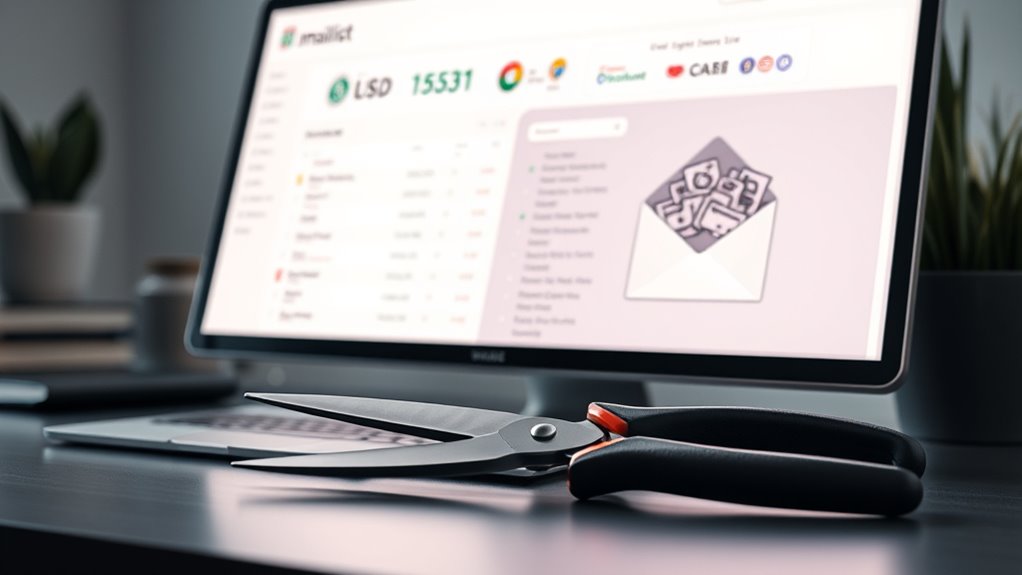Pruning inactive or invalid subscribers from your list improves your email deliverability, so your messages land in inboxes instead of spam folders. It also boosts engagement by focusing on your most interested audience, which can increase opens, clicks, and revenue. Keeping your list clean helps protect your sender reputation and reduces bounce rates. Want to learn more about how effective list hygiene strategies can grow your income? Stay tuned for proven techniques.
Key Takeaways
- Removing inactive subscribers improves email deliverability and inbox placement, ensuring campaigns reach engaged audiences.
- Pruning reduces bounce rates and spam complaints, preserving sender reputation and enhancing campaign effectiveness.
- Focused targeting on active subscribers increases engagement metrics, leading to higher open and click-through rates.
- Cleaner lists enable more accurate segmentation, allowing personalized messaging that boosts conversions and revenue.
- Regular list pruning maintains list health, optimizing campaign performance and maximizing return on email marketing investments.
Understanding the Importance of List Hygiene

Understanding the importance of list hygiene is essential because a clean and well-maintained email list directly impacts your deliverability, engagement, and overall campaign success. When you practice effective list segmentation, you send targeted messages that resonate with specific subscriber groups, increasing relevance and open rates. Content personalization plays a vital role here—by tailoring your messages based on subscriber preferences and behaviors, you foster stronger connections. Regularly updating your list ensures you’re reaching active recipients and avoiding spam traps or invalid addresses. This not only boosts your sender reputation but also improves your chances of inbox placement. Additionally, maintaining list hygiene practices helps identify and remove outdated or inactive contacts, keeping your list healthy and engaged. Prioritizing list hygiene helps you deliver value to your subscribers, keep engagement high, and maximize your email marketing ROI.
Identifying Inactive and Unengaged Subscribers

To keep your list healthy, you need to spot inactive and unengaged subscribers. Look for dormant accounts and review engagement patterns to identify those who no longer interact. This helps you decide whether to re-engage or remove these contacts to improve your overall deliverability. Regularly assessing your list aligns with effective list management practices that support a healthy and responsive audience.
Detecting Dormant Accounts
Detecting dormant accounts is essential for maintaining a healthy email list and ensuring your campaigns reach engaged subscribers. By performing segment analysis, you can identify which subscribers haven’t opened or clicked in a specified period. This process helps you refine your subscriber segmentation, isolating inactive accounts from your active audience. Use engagement metrics to pinpoint dormant accounts, then decide whether to re-engage or prune them. Consider this table as a guide:
| Criterion | Action |
|---|---|
| No opens in 3 months | Mark as dormant |
| No clicks in 3 months | Consider removal |
| Low engagement score | Segment for targeted re-engagement |
| Infrequent interactions | Review for possible pruning |
| Negative feedback rate | Remove or segment for re-engagement |
Effective detection keeps your list lean, improves deliverability, and boosts campaign ROI.
Analyzing Engagement Patterns
After identifying dormant accounts through segmentation analysis, the next step is to examine engagement patterns to spot inactive and unengaged subscribers. By analyzing engagement metrics, you can uncover key subscriber trends that reveal who’s truly interested. Focus on these areas:
- Open and click rates: Low or declining rates indicate disinterest or disengagement.
- Frequency of interactions: Subscribers who rarely open or engage suggest inactivity.
- Timing and consistency: Inconsistent engagement patterns point to unengaged audiences.
Tracking these metrics helps you identify which subscribers are falling off. Recognizing these patterns enables targeted re-engagement strategies or list pruning, ultimately boosting your overall engagement and revenue. Understanding engagement trends keeps your list clean and responsive.
The Impact of Dirty Lists on Email Deliverability

When your email list is cluttered with outdated or invalid addresses, your messages are more likely to land in spam folders or not reach inboxes at all. This can cause your bounce rates to spike and your sender reputation to take a hit. Ultimately, dirty lists hurt your deliverability and reduce the effectiveness of your campaigns. Regularly cleaning your list ensures higher engagement and better campaign results.
Reduced Inbox Placement Rates
Have you ever wondered why your emails sometimes land in spam folders instead of inboxes? Reduced inbox placement rates happen when your list is cluttered with inactive or unengaged subscribers. Here’s how dirty lists affect deliverability:
- Poor sender reputation, making inbox placement harder.
- Reduced engagement signals, discouraging mailbox providers.
- Increased chances of spam complaints, further lowering deliverability.
- Maintaining a healthy subscriber list is essential to preserving your sender reputation and ensuring high inbox placement rates.
To improve this, focus on list segmentation to target active subscribers better and implement subscriber re-engagement campaigns. Cleaning your list ensures you’re reaching genuinely interested recipients, boosting your sender reputation. When your engagement rises, ISPs view your emails more favorably, increasing inbox placement rates. Keep your list healthy, relevant, and engaged to maximize your email marketing success.
Increased Bounce Rates
Ever wonder why your email campaigns sometimes bounce back? One key reason is a high bounce rate caused by dirty lists. When your list isn’t properly segmented, you send emails to outdated or invalid addresses, increasing the chances of bounces. These bounces can hurt your sender reputation and reduce your overall deliverability. Regular list segmentation helps identify inactive or invalid contacts, allowing you to remove or re-engage them. By pruning these addresses, you lower your bounce rate, which signals to email providers that you maintain a healthy list. This improves your deliverability rates and ensures your messages reach your intended audience. Keeping your list clean isn’t just good hygiene—it’s essential for maximizing your email marketing success.
Damaged Sender Reputation
A dirty list doesn’t just cause delivery issues; it also damages your sender reputation, which is crucial for reaching inboxes. When your reputation drops, spam filters become more aggressive, blocking your emails more often. Here’s how this impacts you:
- Your emails get flagged as spam, reducing open rates.
- Mail servers view your sending behavior as suspicious, increasing filtering.
- Persistent issues can lead to blacklisting, making recovery difficult.
- Enforcing active communication helps maintain a positive sender reputation and ensures your emails remain welcomed by recipients.
Maintaining a clean list helps preserve your sender reputation by sending only to engaged recipients. This keeps spam filters at bay and boosts your chances of landing in inboxes instead of spam folders. Pruning inactive or invalid addresses is essential for protecting your email deliverability and revenue growth.
How Pruning Enhances Campaign Performance

Pruning your campaign helps remove underperforming or irrelevant elements, allowing the remaining strategies to thrive. When you clean your email list, you improve list segmentation, ensuring your messages reach the most engaged subscribers. This focused approach boosts subscriber engagement because your content resonates more with your audience. Reduced bounce rates and fewer spam complaints also come from pruning, which means your emails are more likely to land in inboxes. As a result, your open and click-through rates improve, directly enhancing campaign performance. By eliminating inactive or disengaged contacts, you prevent your campaigns from being diluted. This targeted focus allows you to optimize your messaging, increase conversions, and ultimately, drive better revenue from your email marketing efforts. Additionally, positive thinking strategies can help maintain motivation during the pruning process, ensuring consistent list management.
Strategies for Effective List Segmentation and Cleaning

Effective list segmentation and cleaning require a strategic approach to identify and target the right audiences. To do this effectively, focus on these key steps:
- Analyze engagement data to distinguish active subscribers from dormant ones, enabling precise list segmentation.
- Segment your list based on demographics, behavior, or purchase history to tailor your messaging.
- Use subscriber reactivation tactics to reconnect with inactive contacts, encouraging them to re-engage.
- Incorporate insights from data privacy challenges to ensure compliance and build trust with your subscribers.
Re-engagement Campaigns: Reviving Dormant Subscribers

Have you ever wondered how to bring back subscribers who have gone silent? Re-engagement campaigns can help you do just that. Start by offering subscription incentives, like exclusive discounts or early access, to motivate dormant subscribers to reconnect. Personalize your content to match their interests and past behaviors; this shows you value their engagement. Send targeted emails with tailored subject lines and relevant offers, making it easy for them to re-engage. Keep your messaging clear and compelling, emphasizing the benefits of staying subscribed. By combining strategic incentives with content personalization, you increase the chances of rekindling their interest. Regularly analyzing your campaign metrics and adjusting your approach can further improve your success rate through segmentation. Re-engagement campaigns aren’t just about recovering lost subscribers—they also help maintain a healthier, more engaged list that drives revenue.
Tools and Techniques for Maintaining a Healthy List

Maintaining a healthy email list requires the right tools and techniques to guarantee your subscribers stay engaged and your deliverability remains high. First, leverage email automation to send timely, relevant messages that nurture relationships effortlessly. Second, use personalization tactics to customize content based on subscriber behavior and preferences, boosting engagement. Third, regularly clean your list with tools that identify inactive or invalid addresses, preventing deliverability issues. These strategies ensure your emails reach interested recipients and foster loyalty. Incorporate automation workflows to streamline campaigns and personalize each touchpoint for maximum impact. By combining these techniques, you keep your list healthy, engaged, and primed for revenue growth, all while reducing bounce rates and maintaining sender reputation.
Measuring Success: Tracking Revenue Growth Post-Pruning

After pruning your email list, tracking revenue growth becomes essential to evaluate the impact of your efforts. Focus on subscriber retention to see if your cleaned list maintains engagement and generates consistent sales. Use list segmentation to analyze different audience groups and identify where pruning has improved or hindered revenue. By comparing key metrics—such as open rates, click-through rates, and conversions—you’ll understand how your efforts influence revenue. Keep an eye on how retention improves among targeted segments, indicating better quality subscribers. Regularly review these metrics to determine whether your pruning strategy boosts overall revenue or needs adjustment. This ongoing measurement helps you refine your approach, ensuring your list remains healthy, engaged, and profitable over time.
Frequently Asked Questions
How Often Should I Perform List Pruning to Maximize Revenue?
You should perform list pruning regularly to maximize revenue. Typically, every three to six months works well, but it depends on your email segmentation and subscriber segmentation strategies. By consistently cleaning your list, you remove inactive subscribers, improve engagement rates, and boost deliverability. This keeps your email campaigns effective, ensuring you target the right audience and maintain a healthy, responsive list that drives revenue.
What Are the Best Tools for Automating List Hygiene?
Ever wish for a magic wand to handle email segmentation and bounce management? Well, tools like Mailchimp, Sendinblue, and HubSpot are your best allies. They automate list hygiene, ensuring only engaged subscribers stay, which boosts revenue. These platforms help prune inactive contacts, clean bounce data, and keep your list healthy. With automation, you save time and avoid embarrassing spam traps—making your email marketing smarter, not harder.
How Can I Personalize Re-Engagement Campaigns Effectively?
To personalize re-engagement campaigns effectively, you should focus on segmentation strategies that group subscribers based on their behavior, preferences, and engagement levels. Use personalization tactics like tailored content, dynamic email elements, and targeted offers to reconnect with inactive subscribers. By addressing their specific interests and needs, you increase the chances of re-engagement, ultimately boosting your email performance and revenue. Always test and refine these tactics for peak results.
What Are Common Mistakes to Avoid During List Cleaning?
When cleaning your list, avoid common mistakes like neglecting email segmentation, which hinders targeting the right subscribers. Don’t ignore engagement metrics; removing inactive subscribers improves deliverability and open rates. Also, avoid sending generic messages; personalized content boosts engagement. Finally, resist the temptation to delete subscribers prematurely—review engagement patterns first. These steps ensure your list stays healthy, maximizes engagement, and ultimately boosts your revenue.
How Does List Hygiene Impact Customer Lifetime Value?
Your list hygiene directly impacts customer lifetime value by improving email segmentation and boosting subscriber engagement. When you keep your list clean, you reach the right audience with relevant content, encouraging more interactions and conversions. This reduces bounce rates and increases open rates, fostering stronger relationships. As a result, engaged subscribers stay longer, spend more, and become loyal customers, ultimately maximizing your revenue over time.
Conclusion
Think of your email list as a garden. Regular pruning removes dead branches, allowing new growth to flourish. When you clean your list, your campaigns become more vibrant and effective—much like a well-tended garden yields a richer harvest. A clean list boosts deliverability and revenue, turning dormant subscribers into active customers. Keep pruning consistently, and watch your email marketing bloom with fresh, engaging results that drive your business forward.









